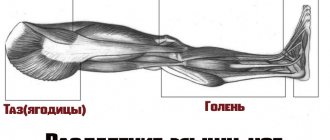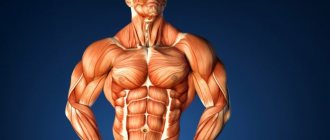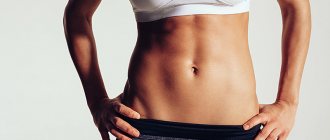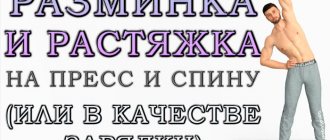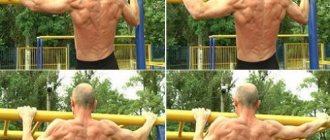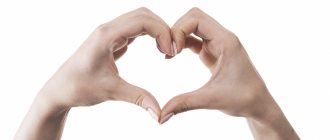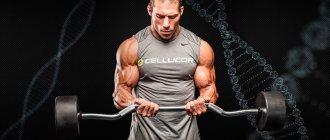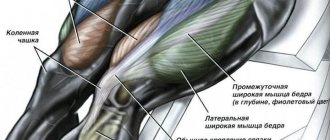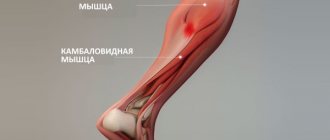Home » Muscle anatomy » Arm muscle anatomy
Wednesday, September 30, 2015
Anatomy of the arm muscles (biceps & triceps): a complete educational program with all the subtleties and secrets...
By arms, people most often mean BICEPS. However, in addition to the biceps, there are also TRICEPS and FOREARM. See explanatory photo below:
Well, let's look at each component in order. Let's start with the biceps.
How to properly train arm muscles
There are several secrets here:
- The growth of small muscles directly depends on the size of large ones
In order for the arm volume to grow by 2 cm, you need to add about 5 kg to your total weight.
It is impossible to weigh 60 kg with an arm volume of 50 cm. Such parameters are typical for people weighing 100-110 kg.
If you want big biceps and triceps, pump up your legs, back and chest!
- Less frequent workouts
In order for the arm muscles to steadily increase in volume, it is enough to train them 1-2 times a week.
Many people make the grave mistake of believing that small groups need little rest.
The fact is that the arms are indirectly loaded when pumping large muscles such as the chest and back, helping to perform the movement.
The triceps are involved in all pressing movements as you pump your chest and shoulders. Well, the biceps are responsible for traction while pumping the back muscles.
Excessive training leads to local overtraining, which results in a complete stunting of growth.
- Multi-joint exercises with free weights are the basis of the program.
It is the “base” with a barbell and dumbbells that promotes the production of testosterone, the main hormone that affects muscle growth.
BICEPS
The biceps consists of two heads:
- The longus (long tendon, but the muscle is small) is located on the outer part of the arm.
- The brevis (short tendon, but large muscle) is located on the inside of the arm.
Both heads originate on the shoulder blade, just in different places... in other words, both heads are connected into one tendon, which is located next to the elbow joint. Subsequently, both heads form a common belly, which passes into a powerful tendon (the tendon itself is attached slightly inward (to the side of the forearm)), which is attached to the radius, and despite their name, both heads have the same length, because the long head has in fact, a longer tendon with which it is attached below to the bone.
The biceps flexes the forearm and rotates it outward (this is supination), which means that in addition to the fact that the biceps can simply bend the arm at the elbow joint, it can also supinate it (i.e., turn the palm towards the thumb).
Through the short head, the biceps takes part in adducting the arm, and through the long head, abducting the arm.
In addition to the biceps, the anterior group of shoulder muscles also consists of the brachialis muscle, which is located below the biceps, as if pushing it out. The main function is to flex the forearm.
FOCUS ON THE BICEPS HEADS
According to statistics, there are no problems with the development of the short head (the one located on the inside of the arm), it responds perfectly to the load, and grows well from any bending of the arm. But with the development of the long head, the one that is located on the outer part of the arm, most people have problems!
Treatment
- In order to fight the outer head (long), you need to move your elbows as far behind your back as possible, this is the only way to engage the outer part of the biceps.
- In order to fight the internal head (short), on the contrary, you need to bring your elbows forward as much as possible.
GRIP when working on BICEPS
- The wider your grip, the more the inner head will work.
- The narrower your grip, the more the outside head will work.
In general, I don’t recommend a narrow grip. In theory, the narrower the grip, the more you will bring your elbows forward, and based on the above (if the elbows are brought forward), then the inner head is strongly activated.
Symptoms of hand tendonitis
The key nuances of wrist joint tendinitis include the localization of its symptoms in the area of inflammation. The primary stage of the disease is characterized by the following manifestations:
- Pain syndrome that increases during physical activity. Irradiation of pain can be observed in nearby areas;
- Crunching when making motor movements of a limb;
- Swelling in the joint area;
- Feeling of stiffness;
- In the area of inflammation, the temperature often rises;
- The appearance of dense formations under the skin.
If you have wrist tendonitis but other symptoms are present, the symptoms and treatment will also be specific.
The presence of hand tendonitis can be judged from the results of studies carried out using instrumental methods and in laboratory conditions. For this purpose the following are appointed:
- X-ray of the joint;
- General blood analysis;
- Study of the synovial fluid filling the joint cavity;
- Ultrasound, which allows us to exclude the presence of pathological processes in the joint area;
- MRI.
Medical specialists conduct a thorough study of the existing symptoms and determine the degree of joint mobility.
The key objective of our activity is to provide highly qualified services with a guarantee of long-term results. At the same time, you can always clarify information about the cost of future treatment and ask other questions that interest you.
What can interfere with muscle growth
The difference in body shape of some athletes following the same training program is explained by the constitution. There are mesomorphs, endomorphs and ectomorphs. In the first two types of constitution, the triceps are large and long, and the muscles in general grow faster. In ectomorphs they are beautiful and peaky (see below).
Muscles may not grow or grow slowly for the following reasons:
- The load does not increase - the muscles will not increase if the load does not increase.
- The load is not meaningful, not purposeful - you need to concentrate on the muscles that need to be developed, and exclude unnecessary ones from the load.
- Insufficient recovery - it is necessary to adhere to small meals (6 to 12 times a day) and get full sleep (at least 8 hours a day).
- There are mistakes in the training technique - it is enough to make minimal adjustments, and the effect will not be long in coming.
Compliance with the first three points is mandatory. And the more strictly they are observed, the faster you will be able to pump up your arms.
EZ bar reduces stress on forearms
The most common mistakes beginners make when training their arms:
- Loading only one muscle group. For example, the desire to pump up only biceps. Growth cannot be achieved this way - the anabolic hormones necessary for growth will not be produced.
- Excessively heavy and high-volume workouts. Take more, throw further - not for this situation, unless anabolic steroids are used. It’s easy enough to overtrain your hands and damage them.
- The load does not increase. The same load creates a limit to the effect - the muscles simply will not grow.
Another way to understand that the load is not bringing the desired effect is when the trained muscles are not felt during exercise.
Causes of hand tendonitis
Wrist tendinitis (styloiditis) occurs against the background of other serious pathologies or develops as an independent disease.
The key factors that provoke the onset of the disease include excessive stress on the tendons.
For wrist tendinitis, as an independent pathological process, the following processes are characteristic:
- The appearance of mechanical damage that occurs against the background of prolonged physical activity;
- The occurrence of microtraumas, which is a consequence of tendon tension during physical exercise;
- Pathological processes that manifest themselves as a result of pathogenic bacteria entering damaged tissue.
Patients who have hand tendinitis due to other reasons often turn to medical care, including:
- Deterioration of metabolism;
- Incorrect posture;
- Degenerative processes in the joint area, which can be triggered by hormonal imbalances, metabolic failures, and increased stress;
- A number of diseases characterized by damage to periarticular tissues and joints;
- Infectious diseases caused by the penetration of pathogens;
- Malfunctions of the immune system associated with prolonged exposure to medications or colds.
Tendinitis of the hand is most common in males.
When drawing up a treatment plan, our specialists take into account not only the nuances of the development of the disease itself, but also the age characteristics of the patient, his lifestyle and gender. In case of diagnosing related processes, we are ready to apply an integrated approach based on the latest highly effective techniques.
Thanks to the constant improvement of professional skills, continuous scientific activity and interaction with large research laboratories, the staff of our medical center are able to put innovative therapeutic methods into practice.
Principles of treatment
There is no single treatment strategy that would suit all patients. Typically, doctors start with less invasive and safer interventions, and if they are insufficiently effective, they move on to more aggressive treatment tactics.
Algorithm of action of an orthopedic doctor:
1. Conservative therapy.
2. Glucocorticoid injections – if other conservative methods are ineffective.
3. Surgical treatment if conservative therapy does not work.
Hand exercise programs
For each muscle group you need to perform basic and isolating (conditionally basic) exercises.
For triceps
Basic:
- Dips.
- Close grip barbell press.
- Smith machine barbell press.
Insulating:
- Extensions at a crossover or vertical block.
- French press of a barbell or dumbbell from behind the head, standing or sitting.
- French bench press.
For biceps
Basic:
- Hammer grip dumbbell curls.
- Raising the barbell for biceps with a reverse grip.
- Standing biceps curl.
Insulating:
- Concentrated dumbbell raises.
- Dumbbell curls on a Scott bench.
- Lifting dumbbells for biceps while sitting or standing.
For beginners
- 1 day. Basic biceps exercise: 2 warm-up and 3-4 sets with working weights, 6-12 repetitions.
- Day 2. Basic triceps exercise: 2 for warm-up and 3-4 sets with working weights, 6-12 repetitions.
- Day 3. Basic exercise for biceps, the number of approaches and repetitions is the same.
- Day 4 Basic triceps exercise, the number of approaches and repetitions is the same.
Example:
- Standing biceps curl: 2 warm-up approaches and 3-4 with working weights, 6-12 repetitions.
- Bench press with a narrow grip (the angle of the bench should be 15-20 degrees lower) or in a Smith machine: 2 warm-up approaches and 3-4 with working weights for 6-12 repetitions.
- Dumbbell curls with a hammer grip while lying on an incline bench: 2 warm-up and 3-4 sets with working weights, 6-12 repetitions.
- Dips: 2 warm-up approaches and 3-4 with working weights, 6-12 repetitions.
- 1 day. Basic biceps exercise: 2 warm-up and 3-5 approaches with working weights, 6-12 repetitions.
- Day 2. Basic triceps exercise: 2 warm-up and 3-5 approaches with working weights, 6-12 repetitions.
- Day 3. Basic exercise for biceps, the number of approaches and repetitions is the same.
- Day 4 Basic triceps exercise, the number of approaches and repetitions is the same.
- Day 5 Isolated biceps exercise 3-4 sets of 8-12 repetitions.
- Day 6 Isolated triceps exercise 3-4 sets of 8-12 repetitions.
For advanced
Example:
- Standing biceps curl: 2 warm-up and 3-5 approaches with working weights, 6-12 repetitions.
- Bench press with a narrow grip (the angle of the bench is 15-20 degrees below the horizontal) or in a Smith machine: 2 warm-up and 3-5 approaches with working weights, 6-12 repetitions.
- Lifting the barbell for biceps with a reverse grip: 2 warm-up and 3-5 approaches with working weights, 6-12 repetitions.
- French press behind the head of a barbell or dumbbell, standing or sitting: 2 warm-up and 3-5 approaches with working weights, 6-12 repetitions.
- Dumbbell curls lying on an inclined bench with a hammer grip: 2 warm-up and 3-4 sets with working weights, 6-12 repetitions.
- Extensions in a crossover or on a vertical block: 2 warm-up and 3-4 sets with working weights, 6-12 repetitions.
Forearm muscles: functions and names of muscles
Brachioradialis muscle or brachyradialis
The largest muscle of the forearm, it is involved in pronation and supination of the elbow joint, returning it to a neutral position. Refers to the flexor muscles.
Flexor carpi radialis
Performs the function of flexing the wrist and elbow joints, abducting the hand.
Flexor carpi ulnaris
Participates in flexion and adduction of the hand, and to a lesser extent contributes to flexion of the elbow joint.
Palmaris longus muscle
Refers to the flexor muscles. Function: flexion of the hand.
Extensor carpi
Participates in the extension of the wrist and elbow joints, and also promotes adduction of the hand.
Extensor carpi radialis brevis
Participates in extension of the hand in the wrist joint, abducts the hand, and promotes extension of the elbow joint.
Extensor carpi radialis longus
Promotes extension of the wrist and elbow joints, as well as abduction of the hand.
Surgery
Styloiditis is treated surgically in the following cases:
- failure of conservative therapy, including glucocorticoid injections, for 1 month;
- blockade of the finger in the flexion position.
The essence of the operation: opening the canal in which the tendon moves and its decompression (removing pressure) for normal gliding. This is a non-traumatic operation that is performed on an outpatient basis under local anesthesia.
The operation is performed on an arm that has been drained of blood using a cuff. Doctors use optics to see arm tissue under magnification and avoid damage to nerves and blood vessels. When surgically treating styloiditis, it is especially important not to damage the sensitive branches of the radial nerve, which are hidden in adipose tissue.
Surgical treatment is highly effective: up to 96% of patients obtain good or excellent results. The risk of complications does not exceed 2%. The main ones are injury to the radial nerve and the formation of keloid scars. In the long term, relapses are observed in only 5% of patients.
In recent years, endoscopic operations have been increasingly performed. They are less traumatic, safer, and reduce the risk of complications. A better aesthetic effect is ensured, since the incision on the skin is smaller. Patients recover faster after such operations.
Rehabilitation after treatment of hand tendinitis
An important part of therapy aimed at eliminating the consequences of tendinitis is the rehabilitation period. It includes therapeutic massage and special exercises. However, rehabilitation measures should be started only after pain has been eliminated and inflammation has been relieved.
The main goal of such exercises is to restore the elasticity of the tendons and strengthen the muscle tissue. At the initial stage, the use of special devices is not provided. Over time, they resort to using an expander.
As for massage procedures, they are carried out with the aim of improving regenerative processes in tissues, normalizing blood flow and improving the elasticity of tendons.
Exercises for shoulder muscles at home
Pulling the projectile to the chin . Standing, place your feet shoulder-width apart. Take a weight (dumbbells or anything that replaces them), lower your straight arms down in front of your body, palms facing your body. As you exhale, keeping your back straight, lift the apparatus to your chin. Spread your elbows out to the sides, keeping them close to your body. After a two-second pause, lower the weight down.
Advice! When doing chin pulls, do not raise your arms above your shoulders.
Swing to the sides . You can work sitting or standing. Place your arms at the sides of your body, palms facing inward. Raise them to the sides, just above shoulder level. Hold the weight briefly at the top and slowly lower it.
Swing forward. A variation of the previous exercise, performed while standing. Lower your outstretched arms with the load down in front of you, palms facing your body. Raise your arms straight up to shoulder level. Hold them at the top for a couple of seconds, then smoothly lower them.
Advice! When performing swings, make sure that the body does not make unnecessary movements. Do not allow the projectile to drop sharply, make movements slowly.
How to pump up your triceps
Triceps brachii, triceps - extensor muscle of the posterior shoulder group. It is shaped like a horseshoe and consists of three heads that intertwine on the back of the shoulder and thus form one common ligament.
It is thanks to the common ligament near the elbow that during work all the heads of the triceps are included in the work simultaneously. At the same time, in different exercises the emphasis is placed on one or two heads. That is, all three work, but the main load is given to a specific area of the triceps muscle.
There are long, lateral and medial heads:
- Long head. This is an internal muscle that attaches to the back of the shoulder blade. When working out, you need to move your arm back as far as possible. Ideally, the shoulder joint should also be included in the process, since the long head is involved in its extension.
- Lateral and medial heads. They are attached to the humerus and only extend the forearm.
When performing exercises, the triceps is activated from the medial head to the long one, depending on the degree of abduction of the arm back and the severity of the load.
Eventually:
- If the load is light, then most of the load falls on the medial head.
- If you increase the load a little, the short, outer head will connect - the lateral one.
- When the load is heavy and the arm is pulled back, the long head is turned on.
From this it becomes clear that the lateral and medial heads work when performing almost any exercise, and training the long head requires special conditions.
Training the long head of the triceps
The long head is attached to the shoulder blade, so for its active operation you need:
- Huge pressure.
- Pulling your arm back or up above your head.
- Connection of the shoulder joint.
- Pressing your elbows to your body.
- Turn the brush outward.
The best exercises for the long head of the triceps:
- French overhead presses while standing or sitting, with your arms raised up.
- Extensions with free weights with the arm moving back.
Triceps exercises
- Bench press with a narrow grip.
- Dips.
- French press with a barbell on an incline bench.
- French overhead barbell press, standing or sitting, the same can be done with dumbbells.
- Extensions in a crossover or on a vertical block.
Safety precautions
- You cannot make sudden movements. When one joint is strained in a movement, jerking other muscles can lead to injury.
- Isolation exercises are best performed after basic exercises.
- French presses can only be performed after warming up. When loading on one joint, be extremely careful when working with large weights.
Conclusion: before moving on to working on the triceps, warm up the muscles with a warm-up and basic exercises.
